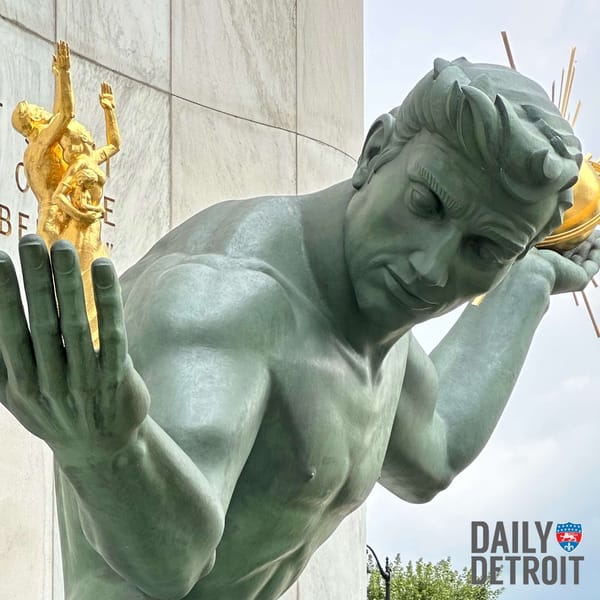In February of 2011, something remarkable and utterly bizarre happened in Detroit. And, like most monumental movements in today’s world, it all began with a tweet:
What followed was this response by then Mayor of Detroit, Dave Bing:
What happened next was nothing short of magic, and proof of the unyielding power of Internet virality.
Local artist John Leonard created a Facebook page, which boldly stated that Detroit needed a RoboCop statue. By the end of its first day, that page received more than 2,000 likes. The explosive success of the Facebook page led to the creation of a Kickstarter campaign by the folks at the Imagination Station. That campaign raised just under $60,000 in 45 days, securing the funds that would turn this wild idea into a reality.
The project had everything going for it, and backers were certain they would see the statue come to fruition in a short time.
Then, just as the rubber seemed to be hitting the road, the project began to sputter.
As it turns out, lurking behind the all the hype and excitement around the statue has been a long and complicated process in order to make this thing go. What set out to be a fun art project with a relatively quick turn-around time has transformed into a marathon effort that no one saw coming, and which is still unfolding to this day.
While there has been intermittent media coverage, the Facebook page still gets regular asks from backers and other interested parties inquiring about the state of the statue.
Well, we asked around, and here’s the story as we know it. You may want to get comfortable.
The Back Story
After securing the Kickstarter funds in early 2011, the first obstacle that appeared was a copyright issue. Unbeknownst to project organizers, in order to create the statue, they needed explicit permission from MGM and Orion Films, who produced and distributed the 1987 film.
Things looked grim until a serendipitous phone call from Pete Hottelet, founder of a company called Omni Consumer Products (OCP) – yes, the company was named after the evil corporation that is the center of the Robocop film.
OCP is in the business of creating replicas of iconic film items, such as the “Sex Panther” cologne that Brian Fantana sports in Anchorman. Hottelet had gotten word of the movement to build the statue and offered to help navigate the copyright issues with MGM, as well as match the first $25,000 donated to the project.
It took nearly two years once the funding drive ended, but with the help of Hottelet, OCP, and Across the Board Creations out of British Columbia in Canada, the 10-foot tall replica model was finally built. Now, it was time to find someone who could build the thing.
The Right Man For The Job
Eventually they settled on world-renowned artist Giorgio Gikas, who is the owner and operator of Venus Bronze Works. Venus, founded in 1984, is one of just 12 foundries in the United States that focuses on large-scale restoration work, and we’re told it’s also one of the best.
Giorgio, a master craftsman and exemplary artist, has been in this line of work since he was 17. He was born and raised in Greece, where his family has been casting bronze for four generations. He came to the U.S. with his cousin to work for his uncle Constadinos Klouvatos in Cincinnati who promised to send him and his cousin to school after a few years of work.
“But that was bull****,” Gikas says with a smile. “He would take us to Gettysburg and leave us there for two to three months at a time to work. Everything in Gettysburg national cemetery I have done. Finally I left working for him joined the army, became a US citizen, and started my own business.”
His studio is a large but discreet warehouse just off of McNichols Road in an industrial area of Detroit’s east side. He leads us into the main area of the workshop where we see the unmistakable Robocop helmet sitting on a table and says, “This is it. This is the RoboCop.”
We stand in awe of the space as Giorgio beings to explain that Venus’s main business is in restoration, not creation. He points out pieces that he and his team are currently restoring, including two statues form the City of Warren, a massive civil war monument from Winchester, Indiana, and a statue from the University of Indiana that someone stole and almost destroyed, which now looks good as new.
It’s the restoration work that pays the bills at Venus.
“That’s the stuff we do 24/7. This,” Gikas says in regard to the RoboCop statue, “we’re doing just to do it.”
You get the sense that he is a true craftsman, who does what he does out of love for that craft.
“You’re never going to become a millionaire doing this work, but I am one of the busiest companies in this field. Doing what I love the most is what’s keeping me going.”
[quote_right]One mold, depending on size, can take anywhere from one day to one week from start to finish.[/quote_right]
He then begins taking us through the process of creating the statue. First, molds must be created for each individual piece of the statue. Then the bronze is melted down in a small crucible furnace, poured into the respective mold, coated in talc powder, and allowed to cool. Operating with just one small furnace and only a few extra hands, it’s immediately clear why getting the piece to this point has taken two years.
“One mold, depending on size, can take anywhere from one day to one week from start to finish,” Gikas says. “Every single piece has to be welded and ground off to make it look like it was never in pieces.”
At this point, Giorgio Gikas and his small team are completing the molds, and the next step is casting the bronze, and then assembling the statue into its final form through a highly meticulous welding process. The dismembered statue lies in sections around the room. He hands me a RoboCop finger the size of a healthy cucumber, which easily weighs 10 pounds.
[quote_left]The statue will weigh one to one and a half tons when it’s finished[/quote_left]
“The statue will weigh one to one and a half tons when it’s finished,” says Gikas.
The project organizers originally told Gikas that they wanted a 7-foot tall statue, but the next thing he knew, a 10 foot sculpture arrived. At some point in the process, the statue had grown by three feet.
With a process as slow and painstaking as this is, those three extra feet can add weeks, even months to the time it takes to finish the statue.
However, the sheer physical scale of the project is only one of the challenges he came across. The next most significant issue has been the budget.
While the $67,000 from the Kickstarter campaign sounds like a good chunk of change, it’s only about half the cost of what a project of this scale would normally cost him to complete.
“The $65,000 is really low for this sort of project,” Gikas says. “Normally, it would be twice that amount. That’s one of the reasons it’s been taking so long. I’ve been robbing Pete to pay Paul, you know?”
“Then there is the cost of bronze, which is $5 per pound. Three years ago it was $4 per pound when we quoted the price.”
At roughly $15,000 for bronze alone, not to mention Giorgio’s rate of $75 an hour, you start to get an idea of just how tight the budget was in order to get it done in Detroit, and also, a compelling reason for the time until completion.
His frustration was apparent. However, despite the criticism the project has endured, Giorgio remains optimistic.
“Some of them understand, and others, they don’t. But it doesn’t matter because it is what it is.”
“You know, at the same time that I’m working on this, I have to satisfy my regular customers, because this statue is a one time shot. I have clients that I’ve had for 30 years and I have to make sure that I finish their work as well,” said Gikas.
And while he has grown tired of the hassle to get the project done, he is sympathetic to the cause.
“I can see their point. It’s OK. It’s going on two and a half years, you know, I want to finish this ****ing project, too. But at the same time I tell them, look, you know from the beginning that you are getting a ten foot sculpture for $65,000, which was originally supposed to be for a seven foot sculpture. Now three feet in this kind of work is one third of the project. They want to finish it for $65K, you know. And I can understand, that’s all they can come up with and I am committed to do it, but you know, I don’t want to go out of business doing it either.”
Another frustration he dealt with early on was due to the media blitz that occurred when the ball got rolling.
“At first I had all this help. Everyone wanted to jump on board, but then they realized how cheap this project is, everyone disappears. So all these other people were supposed to help me, other foundries and this and that. They were here when all the reporters were here, and then as soon as that ended, they all just skipped town and I couldn’t find anybody.”
What about quitting? He could have just as easily said he didn’t want to do it any more.
“It has come a couple times to that point. But we’ll finish it, you know. It’s going to get done. And the City will be very happy that they have it, you know. And everyone who funded it will be very happy. And it will be out of my hair. And all the tourists will go and take pictures of RoboCop.”
The Million Mile Journey
After speaking with Giorgio, we connected with Brandon Walley of the Imagination Station. Brandon, one of the forefathers of the project, matches Giorgio’s sense of exhaustion with the whole thing, but maintains the same unyielding resolve to get this it finished.
And while he agreed that Giorgio has indeed encountered some challenges, he noted that everyone involved have had their share of pain points, too.
The fact is, that when these guys started the whole thing, they never could have imagined it would take this long. They set out to do something on a quick turn around, with the belief they could get it all done in a year or two.
But, as we mentioned earlier, they began running into setbacks almost immediately. The early projections Walley and his team made about the projects completion came before they knew the true scope of the project. Despite being seasoned artists, none of them had ever tried to build a giant bronze statue before, and thus, were unprepared for what lie ahead.
“Every piece of this has taken way longer than we expected,” says Walley. “Honestly, when I look back on the media coverage from early on, and I look at the things I said then (in regard to how long it would take), I definitely had some naivete about the whole thing.”
He pointed out a few specific hang ups including what we’ve talked about earlier. He also notes that they did have other foundries vying for the opportunity to build the statue, some of whom claim they could have done it both cheaper and faster than Giorgio, but they wanted it done by someone who would truly care about the work, and further, they wanted it done here in Detroit.
In an age where most every commodity is outsourced to whoever can churn product out the fastest, it’s refreshing to see a project of this stature stay local, entrusted to hands of a true craftsman and artist who has operated a business in Detroit for more than 30 years.
The End Is Near
This saga boils down to the fact no one knew the can of worms that was about to open when this project launched five years ago. Organizers just thought it would be cool to have a RoboCop statue in Detroit, and the Kickstarter success proves they weren’t alone in their ambition.
Through the years, the intentions of Walley and everyone involved were always good, positive, and honest. No one is getting rich and famous off of this, and there’s no corporation trying to cash in on the end result.
It will simply be a monument for residents and tourists to enjoy, and a testament to the sheer tenacity and will of a focused group of people who’ve persevered to get it done right.
It’s important to note that both Giorgio and Brandon focused on the fact that despite some disagreements, misunderstandings, and many delays, there is no bad blood, and everyone involved in making this happen is still proud of the project and is eager to see it completed.
Gikas believes he will have the project done in the fall, though it’s hard to know an exact date. Once he completes the statue, there is still the issue of where it will go in the city, which is a discussion still unfolding.
“For a monument that’s going to stand the test of time, I’m ultimately okay with it taking this long. The entire process has been a major labor of love for everyone involved and very frustrating at times, but we were always just trying to do this right,” said Walley. “Once the RoboCop Statue is here to protect and serve, he’s here to stay so I’m glad that it will be the best it can be, and made right here in Detroit.”





















